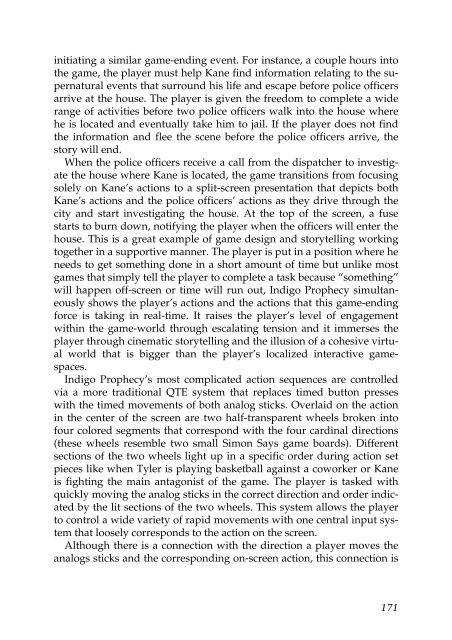Well Played 2.0: Video Games, Value and Meaning - OpenLibra
Well Played 2.0: Video Games, Value and Meaning - OpenLibra
Well Played 2.0: Video Games, Value and Meaning - OpenLibra
Create successful ePaper yourself
Turn your PDF publications into a flip-book with our unique Google optimized e-Paper software.
initiating a similar game-ending event. For instance, a couple hours into<br />
the game, the player must help Kane find information relating to the supernatural<br />
events that surround his life <strong>and</strong> escape before police officers<br />
arrive at the house. The player is given the freedom to complete a wide<br />
range of activities before two police officers walk into the house where<br />
he is located <strong>and</strong> eventually take him to jail. If the player does not find<br />
the information <strong>and</strong> flee the scene before the police officers arrive, the<br />
story will end.<br />
When the police officers receive a call from the dispatcher to investigate<br />
the house where Kane is located, the game transitions from focusing<br />
solely on Kane’s actions to a split-screen presentation that depicts both<br />
Kane’s actions <strong>and</strong> the police officers’ actions as they drive through the<br />
city <strong>and</strong> start investigating the house. At the top of the screen, a fuse<br />
starts to burn down, notifying the player when the officers will enter the<br />
house. This is a great example of game design <strong>and</strong> storytelling working<br />
together in a supportive manner. The player is put in a position where he<br />
needs to get something done in a short amount of time but unlike most<br />
games that simply tell the player to complete a task because “something”<br />
will happen off-screen or time will run out, Indigo Prophecy simultaneously<br />
shows the player’s actions <strong>and</strong> the actions that this game-ending<br />
force is taking in real-time. It raises the player’s level of engagement<br />
within the game-world through escalating tension <strong>and</strong> it immerses the<br />
player through cinematic storytelling <strong>and</strong> the illusion of a cohesive virtual<br />
world that is bigger than the player’s localized interactive gamespaces.<br />
Indigo Prophecy’s most complicated action sequences are controlled<br />
via a more traditional QTE system that replaces timed button presses<br />
with the timed movements of both analog sticks. Overlaid on the action<br />
in the center of the screen are two half-transparent wheels broken into<br />
four colored segments that correspond with the four cardinal directions<br />
(these wheels resemble two small Simon Says game boards). Different<br />
sections of the two wheels light up in a specific order during action set<br />
pieces like when Tyler is playing basketball against a coworker or Kane<br />
is fighting the main antagonist of the game. The player is tasked with<br />
quickly moving the analog sticks in the correct direction <strong>and</strong> order indicated<br />
by the lit sections of the two wheels. This system allows the player<br />
to control a wide variety of rapid movements with one central input system<br />
that loosely corresponds to the action on the screen.<br />
Although there is a connection with the direction a player moves the<br />
analogs sticks <strong>and</strong> the corresponding on-screen action, this connection is<br />
171

















